Rye Barcott's Blog, page 13
October 13, 2015
A Girl’s First Camera: A New Partnership with ARTKIDS Foundation
By: Nick Johnson, Communications Coordinator
—
“What happens when you give children the opportunity to speak for themselves?” This question appears on the website for ARTKIDS Foundation, an organization that provides interested adolescents in Kibera with cameras and photography classes. For over a decade, Carolina for Kibera’s Daughters United program has been asking a similar question about girls in Kibera: “What happens when girls are empowered to speak for themselves?” It is with this shared purpose in mind that we are proud to announce a new partnership between Carolina for Kibera and ARTKIDS Foundation expanding our photography training program for girls!
At first glance, it might not seem like fostering creativity and self-expression is very important in an impoverished place like Kibera. How can taking selfies help a child feed themselves or, better yet, gain access to future opportunities? We believe that when young people are given a chance to express themselves, they develop more effective leadership skills and discover power to change their communities.
Empowering youth to explore their own creativity is an approachable and fun way to help them build a positive self-image and other communication skills from a young age. Giving youth—girls especially—a camera, a pen, or a paintbrush instills in them confidence and even hope. It helps them discover their voice. These qualities, so often missing from girls’ daily life in Kibera, can help them develop the courage to seek additional opportunities in the future, and perhaps unlock a passion or skill they didn’t know they possessed.
To that end, Daughters United proudly offers classes in many creative pursuits, including dance, drama, creative writing, and photography. Daughters United has offered photography workshops for many years, mostly on a small scale with individual photographers. Through this new collaboration with ARTKIDS, the Daughters United program will benefit from having a comprehensive curriculum led by a committed group of photographers. As such, we will be able to vastly expand the size and scope of the program!
This isn’t just a boon for CFK. ARTKIDS Foundation Executive Director, Natalia Jidovanu, started the organization from scratch not too long ago, quickly discovering that building a network in Kibera is harder than it seems when you’re an outsider. When she came across the Daughters United program, it was an instant match: CFK benefits from her photographers’ expertise and ARTKIDS benefits by having a wide student population excited to learn about photography. We’re very excited for this mutually beneficial partnership, and thrilled to see it grow!
Eager to see their photography? We are too! Check out our gallery on Facebook from a recent training session, along with ARTKIDS Foundation’s website!
September 20, 2015
A Special Message for International Peace Day
By: Nicholas Kennedy Juma, Sports Association Assistant Program Officer
—
There is a wide range of literature on the role of young people in conflict situations, especially when it comes to perpetuating violence. Most of the papers tend to focus on young people as violent by nature rather than as a product of their communities. Furthermore, a lot of attention has been paid to youth as agents of conflict rather than as agents of peace. Considering that 65% of Kenyan population is occupied by young people, it is becoming increasingly important that, rather than seeing young people as agents of conflict and destruction, they need to be seen as agents of peace.
Youth must engage in intercultural dialogue and be advocates for social cohesion in their communities. This is the only way of building a just and better society. As we celebrate this year’s International Peace Day, the million-dollar question should be: what must we do to enable youth to become active agents of peace in our society today?
It’s true that young people face particular risk in conflict situations. They can be recruited as soldiers, exploited sexually, or—most commonly—manipulated by political candidates who benefit from conflict. Yet, in a place like Kibera, youth sustain the social fabric, and they survive in an impossible environment. Because of Kibera’s status as a slum, there is an automatic tendency to only view Kiberan youth as agents of violence while overlooking their many positive contributions to a society. This should be something of the past.
Plenty of researchers have theorized about the restoration of peace in conflict-shattered areas. It perhaps comes as no surprise that many of these studies emphasize the involvement of young people in perpetuating violent conflicts without adequately addressing the way youth could be positive instruments in building peace. Redirecting young people’s energy and motivation to peace is essential to bringing peace to an entire community.
So, here are some ideas to help move us forward. To quote the Center for Civil Society and Governance, “Youth are more likely to avoid violence and engage in peacebuilding if they are granted a specific set of opportunities, interrelated and mutually reinforcing, which we call threshold conditions for peacebuilding,” meaning that these activities help hold youth accountable. These include “engaging in political participation, forging connections between youth and their communities, building constituencies for peace, training youth for the workplace, and building youth’s confidence and self-esteem.”[1] By focusing on these, we can make great progress in redirecting youths’ energy from conflict to societal development and peace, which would lead to sustainable peace and security throughout the whole community.
Perhaps most of all, involving youth from the beginning not only strengthens their sense of peace and justice for themselves and their neighbors, but they guide the process every step of the way. They know their community best, and they know what it needs. Empowering them to make those changes is the most efficient way to peace.
[1] Center for Civil Society and Governance, “Youth as a Catalyst for Peace: Helping Youth Develop the Vision, Skills, and Behaviors to Promote Peace.” Link: http://www.ngoconnect.net/documents/592341/749044/Youth+as+a+Catalyst+for+Peace-+Helping+Youth+Develop+Vision,+Skills+and+Beh
September 10, 2015
Bentado’s Clever Plan
In a community where health misinformation is common, spreading the truth requires a lot of quick thinking and problem solving. And sometimes, quick thinking can save lives and prevent disease. Community Health Volunteers (CHVs) working with Carolina for Kibera can run into some tricky situations involving both of these.
Take, for instance, a recent encounter that CHV Bentado ran into when conducting a follow-up visit to the home of baby Ismael. Ismael was discharged from the hospital where he was born before getting the BCG vaccine, a vital vaccine given at birth to prevent tuberculosis. Usually the vaccine is only given on particular days of the week, and hospital staff encouraged Pauline, Ismael’s mother, to return on a day the vaccine was being distributed. However, that wasn’t so easy for Pauline, who believes for religious reasons that no one should be able to see her baby until he is one month old. Waiting a month would make it too late for the vaccine to be effective.
Upon learning that the baby had not gotten the vaccine, Bentado had to think on her feet to come up with a solution. Missing the vaccine was not an option. So Bentado devised a plan: swaddle the baby completely, only leaving space for the baby to breathe, and walk with Pauline to the Tabitha Medical Clinic to administer the vaccine. Bentado had also confirmed ahead of time that they would be attended to immediately upon arrival so that Pauline and Ismael would not have to spend a lot of time at the health facility. With this plan, Ismael got the important vaccine!
Like Pauline, many Kiberan women face barriers to getting their children healthcare. Some of them, like the one Pauline faced with Ismael, are traditional or religious in nature. Others are more social. For example, some women’s decisions about their children’s healthcare won’t be supported by their spouse. Women also often have condescending encounters with healthcare providers, which discourages them from making appointments in the future. CHVs like Bentado are working hard to provide accessible, accurate, and friendly service to women like Pauline.
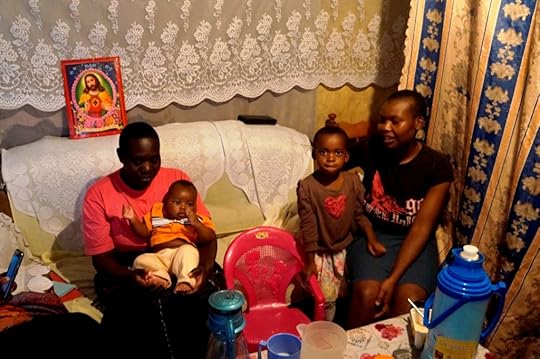
Bentado sits with Pauline and Ismael in their home.
One such service is through Care Groups, small groups of women who meet once a week to talk about their health and their children’s health. Pauline is enrolled in a Care Group and has received much more knowledge than she anticipated. Originally thinking that the group functioned more as a “new parent” class, she was surprised to discuss such a wide range of topics, including her own reproductive health, family planning methods, and how ante-natal doctor visits can bolster the health of the mother as well as that of the child.
Those lessons are what keep Bentado working as a Community Health Volunteer. “Teaching the community how to improve health and prevent illness by adopting healthy practices has been the best part of being a CHV,” she explains, “especially when you see a change in their behaviors. This really motivates us to do more.” She and her colleagues wouldn’t have it any other way. “The community is indeed in charge of their own health and development. We are in fact actively involved in taking care of our own health needs.”
Making Learning Fun During Summer Vacation
By: Jeffrey Okoro, Education Program Officer
—
August marked the second official school vacation period in the Kenyan education calendar. For 4 weeks, students were happy to have a break after the last 3 months of strenuous classes. This presents the perfect opportunity to connect with students in an engaging way about things the “exam-oriented” standard curriculum leaves out: life skills, leadership, goal setting, teamwork, and effective communication.
At CFK, we believe that education should be well-rounded and cover all angles of a student’s intellectual development. That includes standard measures of success in education, such as the KCSE, a national exam similar to the SAT in the U.S. Despite the intensity of the standard high school curriculum for Kenyan students, the national average is often around a C+.
CFK scholars represent an exception. Though they come from underprivileged backgrounds, which often includes growing up in the Kibera slum, attending informal schools, and possibly only having a single parent or no parents, the average performance of our scholars is a B and 90% of our scholars transition to further education options like universities, colleges and technical schools.
For everything else not covered by the curriculum, we turn to more interactive forms of education. Who said learning can’t be fun?
This August, we held a training and learning session for 38 students from the program, along with 4 facilitators. In the past, we’ve held these sessions indoors, but this time we decided to host an adventure at the Nairobi Arboretum. Intended as a trial plot for harvesting trees for rail lines, it is now a park with exotic vegetation and wild animals, including many bird and monkey species. This summer’s session was dubbed, “Making Learning Fun,” and featured events, games, and lectures themed towards improving students’ communication, teamwork, and goal setting skills. (You can see some of the games in the pictures interspersed throughout this story.)
Our 38 participants learned a lot during that session, thanks to the facilitators’ effort to encourage them to actively participate. Each of the students set one or two goals they hope to achieve for the upcoming school session, discussed key points on the core topics, and—perhaps most importantly of all—were exposed to an environment other than Kibera, something that happens too rarely for students who live there.
Earning good grades is vital to students’ success. But CFK’s Education Program also recognizes the important role that exposure visits, collaborative learning, and mentoring play in inspiring students to have a vision for their future and to act upon that vision. With both a solid academic foundation and the tools to grow, our scholars are set up for success—and they are having fun getting there!
August 17, 2015
An Occupational Therapy Student’s Encounter with Kibera
[Editor’s Note: As you will read, CFK welcomed 4 Occupational Therapy students and their professor to Kibera in June to conduct a needs and environment survey for people living with disabilities in Kibera. The project was a huge success and we are excited to continue partnering with them. Below, please enjoy Caryn Biglow’s summary and reflection on her time there.]
—
By: Caryn Biglow, UNC Occupational Therapy Student
This summer, I had the pleasure of traveling to Kibera with a group of fellow Occupational Therapy classmates and my professor. We had two goals: to learn more about the wonderful work that Carolina for Kibera does, and to help them better serve those with disabilities in their community. This year was the first year that the UNC Division of Occupational Science & Occupational Therapy and had partnered with CFK. As occupational therapists, we are trained to work with people living with disabilities of all ages in order to help support them through meaningful activities, regardless of where they are in life. We were excited to bring our unique viewpoints and skill sets to Kibera and see how our interests and training could benefit those in Kibera.
Our team spent just over two weeks in Kibera soaking up as much information as we could about the Kibera community, CFK and the people that work with them, and other organizations in and around Kibera that work with individuals with disabilities. In the two weeks that we were there, we were able to interview 25 different individuals, organizations, and key stakeholders that serve the community. The insights that these interviews provided were invaluable in helping us understand challenges involving disability in Kibera. The biggest theme that emerged from the time spent in both formal and informal conversations with others was that there is significant stigma associated with having a disability. In spite of the stigma, we were able to learn about the wonderful programs that CFK and other local organizations provide for children and youth in Kibera both with and without disabilities.
Some of the conversations that resonated with us the most were those we had with individuals living with disabilities that had overcome the pervasive stigma against them. These individuals had strong family support systems and had a resiliency that kept them going through the worst circumstances. Our entire group felt like these individuals could be strong role models for children that are experiencing stigma related to disability. Their stories of overcoming adversity at schools and in their community are the stories and images that will stay with me for years to come.
In just over two weeks our group was able to help compile a comprehensive resource list of organizations in and around Kibera that support individuals with disabilities. We also developed ideas of de-stigmatizing disability and brainstormed ideas for trainings that might be beneficial for staff and leaders in the community to learn more about disabilities. Our team left Kibera feeling like we had just cracked the surface on how we could assist others in understanding disabilities and how to continue to serve those with disabilities in Kibera. I am incredibly grateful for the time we had in Kibera, the wonderful people that we met, and the time that we spent working with the individuals at Carolina for Kibera. My team and I could not have asked for a more fulfilling two weeks.
August 3, 2015
The First Ultrasound in Kibera
By: Nick Johnson, CFK Communications Coordinator
Many of us are familiar with the image: a pregnant woman lying down, her belly exposed, a doctor moving a wand across her skin. They both watch a monitor that shows a vague, black-and-white outline of a little upside-down baby inside. Sometimes it’s the first glimpse of the child, sometimes a second or third.
We may be familiar with what an ultrasound looks like. In Kibera, many women are not, and many are not aware how vital they are to maternal health. Many believe that only women with ample resources can get ultrasounds, or that they aren’t absolutely necessary. In reality, it’s incredibly important for pregnant women to have proper ante-natal care and doctor’s visits, which should include ultrasounds.
In Kibera, this is especially true. Maternal death is higher in Kibera than many parts of Nairobi and Kenya more broadly. Without access to proper ante-natal care at the early stages of pregnancy, pregnant Kiberan women are at higher risk for miscarriage, losing babies during delivery, or even losing their own lives because of complications.
In response to this need, Carolina for Kibera and the Tabitha Medical Clinic are pleased to unveil a new tool in our mission to provide improved healthcare for women of childbearing age. The Tabitha Medical Clinic now houses the first ever ultrasound machine in Kibera!
Having an ultrasound machine within Kibera will address many problems associated with access to quality care for Kiberan women. “Because it’s the first,” comments Mark Muasa, Head of CFK’s Health Department, “it’s going to have a very large impact for women’s health in Kibera.” The machine will help detect abnormal infections or growths that could threaten the life of the mother or the baby. Knowing things about the baby’s sex will also help the family prepare materially and financially, but also psychologically.
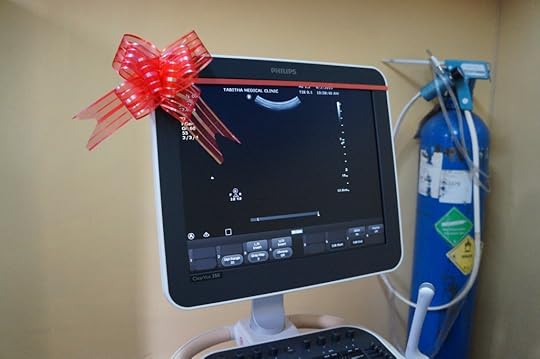 In the past, the Tabitha Medical Clinic staff referred women to outside hospitals and clinics for ultrasounds. Due to a combination of several factors—including time, distance, and overall level of trust—women would neglect to attend appointments that were costlier and farther away. “I think it’s an issue of equity,” explains Mark. “We want to give people the same experience they’ll get in any other private facility. We are trying to close the gaps so women can have access to quality healthcare.” With the ultrasound machine right in residents’ backyards at an organization they trust, more women will feel safe and able to attend appointments and receive quality care.
In the past, the Tabitha Medical Clinic staff referred women to outside hospitals and clinics for ultrasounds. Due to a combination of several factors—including time, distance, and overall level of trust—women would neglect to attend appointments that were costlier and farther away. “I think it’s an issue of equity,” explains Mark. “We want to give people the same experience they’ll get in any other private facility. We are trying to close the gaps so women can have access to quality healthcare.” With the ultrasound machine right in residents’ backyards at an organization they trust, more women will feel safe and able to attend appointments and receive quality care.
In the short time since the Tabitha Medical Clinic staff unveiled the machine, at least 10 women a day have lined up for a visit. That’s 10 women a day who are safer and healthier as they prepare to have children, who will grow up safer and healthier as well. We are very excited to provide this service for Kiberan women!
July 27, 2015
Christine Akinyi, CFK-Nairobits Center Graduate, Speaks on Confidence
Programs at the new CFK-Nairobits Girls’ Center have gotten off to a fantastic start: the first cohort of students graduated in June! Girls took advantage of the classes offered there to learn about computer basics, graphic design, and basic coding, while also learning valuable lessons about self-esteem, entrepreneurship, and other skills to help them seize opportunities later in life.
Those graduates are now actively advising and encouraging the next group of students! One student, Christine Akinyi, has a very important message to share with other girls who might feel like their circumstances won’t ever improve or change. “I would tell them they should never lose hope in themselves, and they should believe in themselves,” she says. “It doesn’t matter how long it will take, doesn’t matter where you are from, doesn’t matter what your background is. You will be called a ‘somebody’ and you will also have changed somebody’s life.”
Watch the video below for Christine’s full message on confidence.
Video by Taekyeong Lee.
July 7, 2015
Lunch and Learn at CFK’s Nutrition Center
By: Courtney Schnefke, 2015 Peacock Fellow
—
Carolina for Kibera’s Lishe Bora Mtaani (“Good Nutrition for the Community”) Nutrition Center for malnourished children under 5 years old just passed its second birthday, and it’s making such an impact in the community!
It’s estimated that malnutrition leads to almost half of all deaths of children under 5 years old.* This means, globally, we are losing 3 million children each year from preventable causes. Additionally, more than 200 million children don’t reach their full developmental potential due to poverty, poor health, malnutrition, and inadequate early childhood care. Malnutrition often leads to a vicious cycle: the child is at risk for poor health from birth, which leads to lack of school readiness, poor academic achievement and educational attainment, and then lack of economic opportunities and poverty in the future.** Ensuring our world’s youngest and most disadvantaged children have access to proper nutrition, health care and early childhood education demands our immediate attention.
CFK’s Nutrition Center is tackling these issues head on. Children who have been identified as moderately or severely malnourished by Community Health Workers are brought to the center each morning for 8 weeks where they receive rehabilitative therapeutic foods, snacks, a nutritious lunch of locally available foods and lots of play time. The Center’s Nutritionist, Esther, also offers one-on-one counseling for moms and coordinates group educational sessions on topics such as breastfeeding, complementary feeding, and sanitation for not only the families of children attending the Center but also for pregnant and lactating women in the community. As a CFK Peacock Fellow, my main projects related to the Nutrition Center this summer include examining how we can incorporate even more early childhood development (ECD) programming and assessments for children and their families to measure progress, as well as assisting with the Nutrition Center’s annual evaluation.
![IMG_1115 [re-size]](https://i.gr-assets.com/images/S/compressed.photo.goodreads.com/hostedimages/1436916880i/15518557._SY540_.jpg) While it has certainly been enriching to put what I have learned in a North Carolina classroom into practice in the Kibera community, it has been even more enriching to spend mornings and afternoons with the children at the Nutrition Center. Reading about the connection between nutrition, ECD programming, and the lifelong impact they can have on children stirs within me a deep motivation to put this research into practice. How profound it is that what happens in the first five years (and especially the first two years) of a child’s life can affect that child’s trajectory for the rest of his or her life. This feeling of motivation to make a difference is only magnified by the little moments with the kids: when I help a little girl eat her lunch, or watch the children’s faces light up when they play with toys, like water bottles filled with rice, clothespins and rainbow erasers. And I simply just melt when a child stops crying when I rub their back or smile when I play peek-a-boo.
While it has certainly been enriching to put what I have learned in a North Carolina classroom into practice in the Kibera community, it has been even more enriching to spend mornings and afternoons with the children at the Nutrition Center. Reading about the connection between nutrition, ECD programming, and the lifelong impact they can have on children stirs within me a deep motivation to put this research into practice. How profound it is that what happens in the first five years (and especially the first two years) of a child’s life can affect that child’s trajectory for the rest of his or her life. This feeling of motivation to make a difference is only magnified by the little moments with the kids: when I help a little girl eat her lunch, or watch the children’s faces light up when they play with toys, like water bottles filled with rice, clothespins and rainbow erasers. And I simply just melt when a child stops crying when I rub their back or smile when I play peek-a-boo.
The Nutrition Center team members certainly have their hands full on a daily basis. Taking care of, feeding, changing, and playing with dozens of children for 7-8 hours daily is no small task. But they’re committed because they know the impact they’re having and that the reward of children flourishing is worth the hard work. The hours I spend there usually fly by, and I leave feeling hopeful for these children’s future. It’s hard not to be when follow-up visits to families and last year’s annual evaluation revealed a 100% cure rate from malnutrition, as well as reports of continued developmental progress for those who have graduated from the program.
All over the world, young children are the most vulnerable group in any population, and they truly are the future of our global community in every sense. It has been an honor to work with, contribute to and be internally impacted by a program that strives to make sure these little ones have the best start in life they can.
—
* Black, RE., et al. (2013). Maternal and child undernutrition and overweight in low-income and middle income countries. The Lancet, 382(9890), 427-451. http://dx.doi.org/10.1016/S0140-6736(13)60937-X
** Grantham-McGregor, S., et al. (2007). Developmental potential in the first 5 years for children in developing countries. The Lancet, 369, 60-70.
“I Can Be Anything I Want in the Future”: Joshua Ong’eta’s Journey through School—and Beyond
By: Scott Weathers, CFK Intern, American University
—
Many aspects of life in Kibera—both the awful and hopeful—are often said to be tied to good or bad luck. As described by Paul Farmer, co-founder of Partners in Health, people in low-income countries sometimes use the term “stupid deaths” to describe accidents that result in the deaths of poor people. Alternatively, when something good comes around, people commonly treated as second-class citizens often attribute it to fate. For example, recent graduate Joshua Ong’eta said that he felt incredibly “lucky and surprised” to have won a Carolina for Kibera scholarship through CFK’s Education Program.
Yet, Joshua’s success cannot be tied to just luck. On the contrary, Joshua’s hard work over four years of high school speaks volumes regarding his work ethic, drive, and potential. In high school, Joshua succeeded in a range of courses, including Swahili, German, chemistry, and physics, which he names as his favorites. Outside of school, Joshua certainly kept busy. He has been involved in virtually every extracurricular activity available to him, ranging from drama and music to soccer and the Kenya Scouts Association (similar to the Boy Scouts of America). Through the Scouts, he undertook many service activities in Kibera, earning him an award from Kenyan President Uhuru Kenyatta last year. On top of all this, he is also one of CFK’s longest serving volunteers, somehow finding time to work on various CFK projects, including helping with CFK’s data collection system and other community outreach projects.
Joshua’s future goals are similarly diverse, spread across engineering, politics, and charity. In college, Joshua says, “I want to run for Class President or Senator. That way, I can begin to develop the connections and skills that will help me run for office when I return to Kenya.” Although Joshua plans to work initially as an engineer, he continues to look beyond his next step when planning for the future. For example, once Joshua has improved his own economic standing as an engineer, he hopes to pursue other projects that will allow him to give back to his community, like running for higher political office, starting a charity in Kibera, or owning a Kenyan soccer club.
![Joshua 1 [re-size]](https://i.gr-assets.com/images/S/compressed.photo.goodreads.com/hostedimages/1436504216i/15469111._SY540_.jpg) It’s easy to see what makes Joshua so ambitious. When I asked him about the most valuable lesson he learned in high school, he simply replied, “Independence.” Joshua attended a boarding school, which meant spending months away from home and his large family at a time. He said, “I love going to school with all different kids of students, rich and poor. It’s amazing to know that no matter where I am right now, I can be anything that I want in the future.”
It’s easy to see what makes Joshua so ambitious. When I asked him about the most valuable lesson he learned in high school, he simply replied, “Independence.” Joshua attended a boarding school, which meant spending months away from home and his large family at a time. He said, “I love going to school with all different kids of students, rich and poor. It’s amazing to know that no matter where I am right now, I can be anything that I want in the future.”
Acting on his determination, Joshua is applying to undergraduate engineering programs in Kenya, Turkey, the United Kingdom, and the United States. From Joshua’s case, it is clear that “dumb luck” has nothing to do with his success. Rather, talent and opportunity in Kibera can thrive when it is supported and nurtured. In Joshua’s words, “There are so many bright minds in Kibera. It is only our job to support them.”
June 19, 2015
“Words Alone Cannot Express My Gratitude”: Laurine Otawa Has Completed Her Diploma Course!
 Earlier this year, we mentioned that Laurine Oloo Otawa, recipient of CFK’s Alan Cross Memorial Scholarship, had plans to graduate in December. Those plans, as Laurine told us recently, are officially set in stone!
Earlier this year, we mentioned that Laurine Oloo Otawa, recipient of CFK’s Alan Cross Memorial Scholarship, had plans to graduate in December. Those plans, as Laurine told us recently, are officially set in stone!
Laurine wrote to us earlier this week to inform us that she has finished her Diploma in Technology Health Records and Information Technology, which she has earned from the Technical University of Kenya. Now, she only has to wait for her graduation day in December of this year to officially be considered a Health Records and Information Technology specialist.
In case you aren’t acquainted with Laurine, she was awarded the Alan Cross Memorial Scholarship in 2012. Laurine’s zeal for education and determination to become a health information professional were clear from the beginning. After she was awarded the scholarship—which is designed specifically for students interested in entering medical-related fields—she made it clear that she wanted to work and spend time in a place that would fit her interests and career choice; as a result, she began working as a janitor at the Tabitha Medical Clinic. Towards the end of her diploma course, as she picked up more skills, she began volunteering at the clinic as well, managing several patient records. Her ability to be flexible and versatile was admired by everyone with whom she worked.
Now that she’s finished with her Diploma, she is ready to put her skills to use. In that same correspondence that she shared with us, she thanked CFK and the family of late friend and board member, Alan Cross, who generously supported her through the years. You can read her full message below:
“I take this opportunity to thank the Alan Cross family and the Carolina for Kibera family for helping me come this far. I have finished my diploma course in health records and information technology, which could not have been possible without your help. Words alone cannot express my gratitude but I pray to the good Lord to bless you. Alan Cross family, thank you and thank you again – for today, my life is no longer the same as yesterday.”
Rye Barcott's Blog
- Rye Barcott's profile
- 7 followers



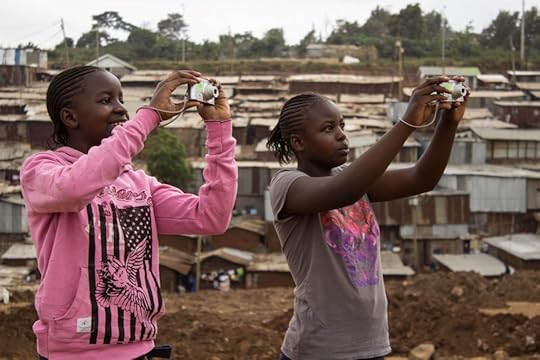
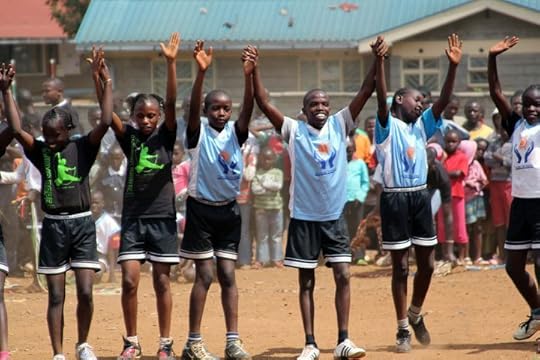

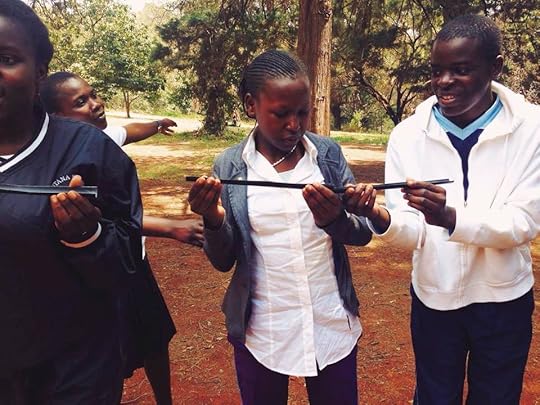
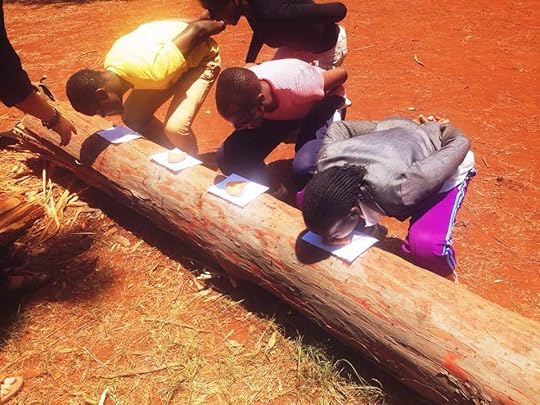
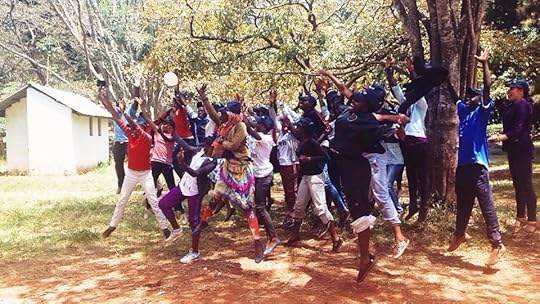
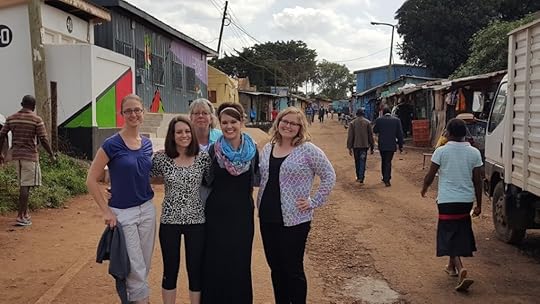
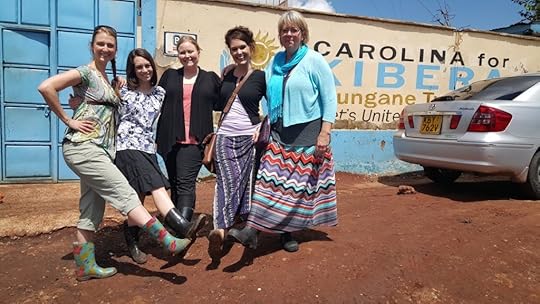

![IMG_1131 [re-size]](https://i.gr-assets.com/images/S/compressed.photo.goodreads.com/hostedimages/1436916880i/15518556._SX540_.jpg)
![Joshua 2 [re-size]](https://i.gr-assets.com/images/S/compressed.photo.goodreads.com/hostedimages/1436504216i/15469110._SX540_.jpg)

